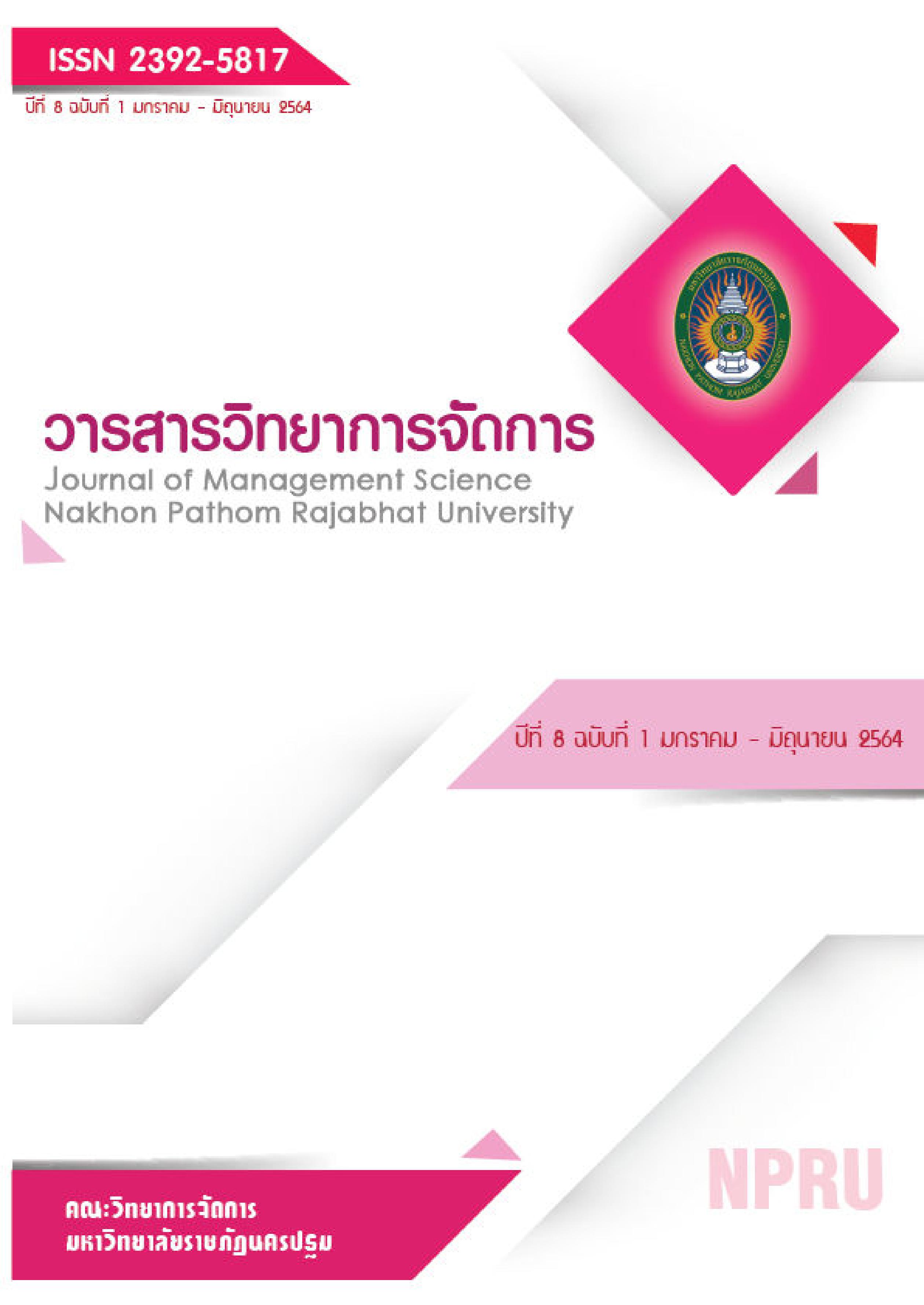Causal Factors Influencing Risk Management of Electronic Commerce for Small and Medium Enterprises in The Central Region of Thailand
Main Article Content
Abstract
The objectives of this research were: (1) to study causal factors influencing the risks of e-commerce for small and medium enterprises, (2) to study management of risks influence of e-commerce for small and medium enterprises and (3) to suggest causal factors influencing risk management of e-commerce for small and medium enterprises. This research was a quantitative research using questionnaires as a tool to collect data. The sample consisted of 400 people using the formula of Cochran (1953). The statistics used for data analysis were percentage, mean, standard deviation, Pearson’s correlation coefficient and analyzed the structural equation modeling: SEM.
The results found that:
Findings from the research suggested that information technology, consumer behavior and information security had direct and positive influence on enterprise risk management. By examining the construct validity of information technology model consists of 4 components: data devices network and personnel the research founded the information technology model is consistent with the empirical data. Examining the construct validity of consumer behavior model which consists of 3 components: attitude user interface quality and security perception the research founded the consumer behavior model is consistent with empirical data. Examine the construct validity of security model which consists of 3 components: confidentiality integrity and availability the research founded the security model is consistence with empirical data.
The examining the construct validity of enterprise risk management model which consists of 4 components: communication support from top management trust and organization structures the research founded the enterprise risk management model is consistent with empirical data.
In addition, information technology was indirectly influenced by enterprise risk management by passing on consumer behavior and security. Consumer behavior was indirectly influenced by enterprise risk management by passing on security. In enterprise risk management model, the research founded the most influential variables in enterprise risk management were information technology consumer behavior and information security, respectively.
Article history: Received 14 November 2020
Revised 22 January 2021
Accepted 1 November 2021
SIMILARITY INDEX = 0.00 %
Article Details
The views and opinions of the article appearing in this journal are those of the author. It is not considered a view and responsibility of the editorial staff.
References
ชิณโสณ์ วิสิฐนิธิกิจา และอิงอร ตั้นพันธ์ (2559). ศึกษาวิจัยเรื่องตัวแบบการสร้างความได้เปรียบเชิงการ แข่งขันในอุตสาหกรรมเครื่องปรับอากาศ. วารสารบัณฑิตวิทยาลัย มหาวิทยาลัยราชภัฏสวนสุนันทา. 8 (ฉบับพิเศษ). 425-431.
ณัฐธยาน์ ภัทรพิเศษวงศ์. (2556). โมเดลสมการโครงสร้างของผลการดำเนินงานระบบโลจิสติกส์และ การบริหารลูกค้าสัมพันธ์ในธุรกิจพาณิชย์อิเล็กทรอนิกส์. วิทยานิพนธ์ปริญญาหลักสูตรบริหาร ธุรกิจมหาบัณฑิต. มหาวิทยาลัยเกษตรศาสตร์.
นันทพร ชเลจร. (2562). โมเดลความสัมพันธ์เชิงสาเหตุของปัจจัยที่มีอิทธิพลต่อ ความภักดีของลูกค้าธุรกิจสตาร์ทอัพประเภทพาณิชย์ อิเล็กทรอนิกส์. วารสารสุทธิปริทัศน์. 33 (107). 193-205.
มณฐิณี ประเสริฐลาภ. (2558). การเปรียบเทียบความน่าเชื่อถือของผลการวัดแบบวัดเจตคติของลิเคอร์ท. วารสารศิลปากรศึกษาศาสตร์วิจัย, 7 (2). 249-258.
ลัดดาวัลย์ เพชรโรจน์ และอัจฉรา ชานิประศาสน์. (2545). ระเบียบวิธีการวิจัย. กรุงเทพมหานคร:พิมพ์ดีการ พิมพ์.
วันดี รัตนกาย. (2554). พฤติกรรมการซื้อสินค้าในเครือข่ายสังคมออนไลน์เฟซบุค. วิทยานิพนธ์. นครปฐม : มหาวิทยาลัยศิลปากร.
ศิริชัย กาญจนวาสี. (2545). ทฤษฎีการประเมิน. (พิมพ์ครั้งที่ 3). กรุงเทพมหานคร : สำนักพิมพ์แห่ง จุฬาลงกรณ์มหาวิทยาลัย.
สุรีรัตน์ ชดช้อย. (2560). อิทธิพลการกำกับของการบริหารลูกค้าสัมพันธ์ที่มีต่อความภักดีของลูกค้า อย่างยั่งยืนของอุตสาหกรรมอัญมณีและเครื่องประดับ. ปริญญาบริหารธุรกิจดุษฎีบัณฑิต. มหาวิทยาลัยรามคำแหง.
สำนักงานส่งเสริมวิสาหกิจขนาดกลางและขนาดย่อม. (2558). “นวัตกรรม” นำ “รวย”. SMEs Today, 12 (102). 86-96.
Angela. V. Hausman Eid and Mustafa. I. (2011). Determinants of e-commerce Ccustomer Ssatisfaction, Trust, and Loyalty in Saudi Arabia. Journal of Electronic Commerce Research; Long Beach 12.(1) : 78-93.
Chatterjee S., Wiseman, R.M., Fiegenbaum, A. and Devers, C.E. (2003). Integrating Behavioural and Economic Concepts of Risk into Strategic Management: The Twain Shall Meet. Long Range Planning, 36: 61-79.
Chung Ki-Han and Shin Jae-Ik. (2010). The Antecedents and Consequents of Relationship Quality in Internet Shopping. Asia Pacific Journal of Marketing and Logistics, 22 (4), 473-491.
COSO. (2004,). Committee of Sponsoring Organizations of the Treadway Commission, Enterprise Risk Management-Integrated Framework, Retrieved May 20, 2019, from http://www.coso.org/erm-integratedframework.htm.
Cochran, W.G. (1953). Sampling Techniques. New York: John Wiley and Sons. Inc.
Crockford, N. (1986). An Introduction to Risk Management. (2nd ed.) Woodhead-Faulkner, Cambridge.
Dkudiene and McCorkle. (2015). The Effect of Eshops’ Service Quality on Lithuanian Consumers’Purchase Intentions. International Journal of Business, Marketing, and Decision Science, 8 (1), 43-59.
Foxall, G. R., and Sigurdsson, V. (2013). Consumer Behavior Analysis: Behavioral Economics Meets the Marketplace. Psychological Record.
Gahin F.S. (1967). A Theory of Pure Risk Management in the Business Firm. The Journal of Risk and Insurance, 34 (1): 121-129.
Garatwa W. and Bollin, C. (2002). Disaster Risk Management: Working Concept. Deutsche Gesellschaft für Technische Zusammenarbeit (GTZ), Eschborn. Retrieved May 20, 2019, from http://www2.gtz.de/dokumente/bib/02-5001.pdf.
Henriksen, P. and Uhlenfeldt, T. (2006), Contemporary Enterprise-Wide Risk Management Frameworks: A Comparative Analysis in a Strategic Perspective, Andersen T.J. (ed.), Perspectives on Strategic Risk Management: 107-130. Denmark: Copenhagen Business School Press.
Petroni G., Venturini K. and Verbano C., (2012). Open Innovation and New Issues in R and D Organization and Personnel Management,.The International Journal of Human Resource Management, 23(1) : 147-173.
Kasai,P. and Boonsathorn, W. (2018). Factors Leading to Work Passion for Innovative Work Behavior: Case Study of Small Hotel Business in Thailand. Dusit Thani College Journal. 12 (1). 1-15.
The Vendran V.,; Mawdesley M.J., (2004). Perception of Human Risk Factors in Construction Projects: an Exploratory Analysis. International Journal of Project Management, 22, 131-137.
Verbano, C., and Venturini, K. (2013). Managing Risks in SMEs: A Literature Review and Research Agenda. Journal of Technology Management and Innovation, 8, 186-197. https://doi.org/10.4067/S0718-27242013000400017
Verbano C. and Venturini K. (2011). Development Paths of Risk Management: Approaches, Methods and Fields of Application. Journal of Risk Research, 14(5-6) : 519–550.
Verbano, C. and Turra, F. (2010). A Human Factors and Reliability Approach to Clinical Risk Management: Evidences from Italian Cases. Safety Science, 48(59): 625–39.
Wu, S.C., Cao, Z.H., Li, Z.G., Cheung, K.C. and Wong, M.H. (2005). Effects of Biofertilizer Containing N-fixer, P and K Solubilizers and AM Fungi on Maize Growth: a Greenhouse Trial. Geoderma, 125:155–166.


